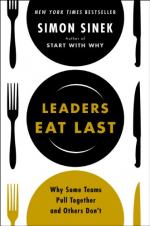|
This section contains 547 words (approx. 2 pages at 400 words per page) |

|
Leaders Eat Last Summary & Study Guide Description
Leaders Eat Last Summary & Study Guide includes comprehensive information and analysis to help you understand the book. This study guide contains the following sections:
This detailed literature summary also contains Topics for Discussion on Leaders Eat Last by Simon Sinek.
“Leaders Eat Last” by Simon Sinek explains why most people hate their jobs and why some people simply love their jobs. Job satisfaction is rooted in the environment that the leader establishes. The leader can be the CEO, an executive, manager or team leader. What’s important is that a good leader isn’t concerned with his title and importance, he is focused on making a workplace environment in which the employee feels safe and feels he or she belongs. It’s a Circle of Safety in which employees grow, learn and become real assets to the corporation.
Employees feel secure in this circle and protected by their leader. They learn to trust and cooperate and to speak up without fear of repercussions. The building of trust within the group is essential. The employees learns to trust the leader because he is consistent, tells the truth, does not have his own secret agenda and is always there to support and counsel his employees. Employees learn to trust each other and work together as team. They emulate the qualities of the leader. They want to do their best for the team, the leader and for themselves. If a member of the group, leader or peer, is caught in a lie or is exposed for self-centered actions, the trust begins to die on the vine.
Author Sinek takes the reader literally from the Paleolithic Age all the way to modern times with stops in various eras including the 1920s, the Great Depression, World War II, and each decade from the 1960s on. In each of these eras, Sinek illustrates how trust and teamwork were a part of man’s survival. Cavemen used the survival system to look for food and shelter while modern day traders use the same system to hunt for the best deal of the day.
Survival is not just an intellectual matter. There is a direct and dynamic physiological impact on matters of survival and success. There are four bodily chemicals that are all designed to assist in the survival of the species. Sinek explains how and when the “selfish” chemicals of endorphins and dopamine are released and the impact they have. These chemicals are associated with short-term happiness and joy while the “selfless” chemicals of serotonin and oxytocin operate on a more serious level and promote confidence and self-worth and team work. The release of these chemicals is involuntary and can be brought on by internal as well as external stimulants. Therefore, a leader with integrity and focus on the employee can cause the release of these chemicals. The employee can cause the release of his own chemicals when he achieves a goal or solves a problem.
Selfless leaders with integrity unfortunately do not abound. There are leaders who are focused on making money and his or her advancement. Such leaders can be the downfall of a team or a corporation because the trust that is essential for success evaporates. Sinek discusses trust on a broader level including the loss by the public in its non-functioning Congress and in the news media that is no longer driven by the news of the day but by whatever will drive profits. Sinek provides a pathway for everyone to one day say, “I love my job.”
Read more from the Study Guide
|
This section contains 547 words (approx. 2 pages at 400 words per page) |

|



